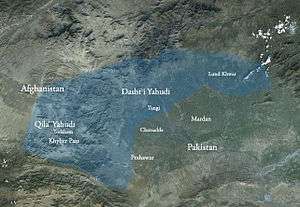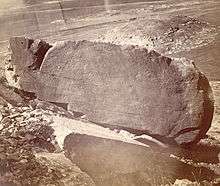Dasht-e Yahudi
Dasht-e Yahudi (Urdu: دشتِ یہودی, Persian: دشتِ یهودی, Hindi: दश्त-ए-यहूदी), or the Jewish Desert, is a region referred to by Persian and early Mughal historians for a stretch of territory that comprised the most western parts of modern-day Peshawar, Charsadda, Malakand and Mardan districts where these border with Khyber Agency and Mohmand Agency.[1] Although not a desert, it is a semi-arid area in most of its parts.
In its Mughal usage, it was often used as a derogatory term for the Pashtun tribes, namely the Afridi, Khattak and Yusufzai who dwelled these parts and often waylaid Mughal caravans and trade routes. It was a reference to their Jewish heritage.
The Mughal emperors despite their vast armies were throughout their long dynasty unable to control the Pashtuns.[2]
The term is no longer used in modern times.
Etymology

The term Dasht-e Yahudi literally means, the "Jewish Desert" in Urdu and "Jewish wasteland" in Pashto.[3] It is an archaic term that first appears in Persian, Mughal Empire (Pashtun) texts.[4]
The word "dasht" means 'desert' or 'field' in Persian. The same word is also used in Pashto and sometimes Urdu or Hindi where it means both an arid area (waste) or a desert. The area termed Dasht-e Yahudi however is not a desert but used to be a semi arid uncultivated area.
Literally the Jewish Desert, the area used to be barren and mountainous with sporadic dwellings and a rare village or two. In modern times, it has been extensively cultivated and for the most part is lush and green through canal systems and rivers.
Origin
In Persian and Mughal historical texts and rarely in Afghan texts, it is always found with another closely related term, Qil' Yahudiya or Qila Yahudi. The word Qil' Yahudiya literally means the Jewish citadel or fort.
Dasht-e Yahudi
The term Dasht-e Yahudi was used for the most Western parts of modern-day Peshawar, Charsadda, Malakand and Mardan districts where these border with Khyber and Mohmand Agencies. Whereas the word Qil' Yahudiya was applied for what is now the Khyber District and the Khyber Pass.
People and tribes
Three major Pashtun tribes were settled in the area. The Afridi, Yusufzai and the Khattak.
The Afridi are settled in the western part of the Dasht-e Yahudi, the Yusufzai on the eastern part it, and the Khattak in the central and northern parts. Additionally, the Mohmand tribe is also present in the northwest of the area. These were the people stated to love their early Mughal and pre-Mughal era, up until the present day. Both the Khattak and the Yusufzai were notorious for ransacking Mughal supply lines and trade routes, so much so that the Mughals had to build the Attock Fort to defend against it.

Ashoka's Aramaic stone edicts
Ashoka, popularly known as 'Ashoka the Great', was an Indian emperor of the Maurya Dynasty who ruled almost all of the Indian subcontinent from ca. 269 BC to 232 BC.
Ashoka’s famous stone tablets and Edicts of Ashoka, some of which are found within this Dasht-e Yahudi regions of Shahbaz Garhi, Mardan, Sawabi, have inscriptions in the language of Aramaic. This is because in addition to trade ties with ancient Israel, Antioch and Greece, Jewish tribesmen (Bani Israel or Banai Israel) were also settled in this area.

Qil' Yahudiya
The word Qil' Yahudiya, was an archaic term used by early Arab, Persian and Mughal historians for the area that in modern-day Pakistan is located in the Khyber Agency and is simply known as Khyber. The word Khyber is now part of the name for the Pakistani province of Khyber Pakhtunkhwa and the famous Bab-e Khyber, the pass through which countless armies attacked India.
In its usage, the term Qil' Yahudiya or Qila-e Yahudi thus stands for the Afridi tribesmen that held that Khyber pass and the mountainous ranges known as the Sulaiman Mountains or Kuh-e Suleiman and the Hindu Kush.
See also
- Nimat Allah al-Harawi Author of Tarikh-i-Khan Jahani Makhzan-i-Afghani (The History of the Afghans)
- Durand Line
- Federally Administered Tribal Areas, Pakistan
- Khyber Pakhtunkhwa
- Khyber Agency
- Pakthas
- Pashtun people
- Pashtunistan
- Theory of Pashtun descent from Israelites
References
- 1970, Pakistan Historical Society (1970). Journal of the Pakistan Historical Society, Volumes 18–19, Pakistan Historical Society, 1970]. Pakistan Historical Society. p. 32 pages.CS1 maint: numeric names: authors list (link)
- Muḥammad Shafīʻ, Ṣābir (1966). Story of Khyber]. University Book Agency- Peshawar (Pakistan). p. 2.
- Maulana Abdul Haq. Muhammad in World Scriptures (Vol. 2); Advent of Holy Prophet Muhammad Foretold in the Books of the Old Testament of Jews and the New Testament of Christians.
- Rauf Khan Khattak (17 February 2008). "Recurring patterns in tribal uprising". The News on Sunday. Archived from the original on 3 March 2016.
Footnotes
- Usage of the term, Journal of the Pakistan Historical Society, Volumes 18–19, Pakistan Historical Society, 1970
- Recurring patterns in tribal uprising THE NEWS 17 Feb 2008. Retrieved 20 feb 2008
- Introduction to the article, Journal of the Pakistan Historical Society, Volumes 18–19, Pakistan Historical Society, 1970
- Introduction to the article, Journal of the Pakistan Historical Society, Volumes 18–19, Pakistan Historical Society, 1970